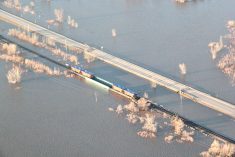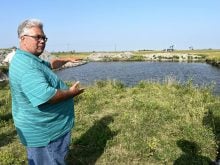The Canada Water Agency became official in October, and the agricultural community appears to be on board.
“With them being located here in our own backyard, KAP will have a unique opportunity to be on the ground and bring forward the perspectives of Manitoba producers to help inform their work,” Brenna Mahoney, general manager of Keystone Agricultural Producers, said during the agency’s official launch in Winnipeg Oct. 16.
“We look forward to engaging with their team in meaningful discussions to highlight the importance of water and environmental stewardship to Manitoba producers’ operations.”
Read Also

Calling all Co-operator readers
Hey farmers, we want to hear your Manitoba Co-operator stories: the articles that stuck out, the farm history you watched on our pages.
The goodwill shown toward the new federal initiative should come as no surprise, considering the important role water plays in all aspects of agriculture. We hope this amicable relationship continues.
However, a deeper dive into the agency’s mandate raises potential red flags that must be addressed.
The mandate includes protecting Canada from water pollution, and according to the federal government, that includes damaging effects from industrial and agricultural activities.
Farmers should not get a free pass if their activities threaten water quality, but past experience shows that governments can be ham-fisted when it comes to suggesting solutions to a problem.
Ottawa’s targets for reducing emissions from fertilizer are a good example. The policy wonks who came up with those targets probably didn’t realize they were walking into a minefield. From their perspective, who could argue with a goal to reduce greenhouse gas emissions associated with fertilizer application by 30 per cent below 2020 levels by 2030?
They even added an assurance on a website — and in bold face, for good measure — that “there is no mandatory reduction in fertilizer use on Canadian farms.”
The architects of this initiative likely thought they were golden, but it didn’t work out as planned. Producer response was hostile, and it was obvious that many thought the targets would become mandatory rather than voluntary.
This can be partly explained by the deep suspicion many farmers hold for the current federal government, but it also showed that Ottawa did a miserable job of communicating the voluntary nature of the targets and their overall purpose.
Instead of dictating targets from the top down, government should have worked with farm groups and individual farmers from the start.
There’s a lesson here for the new water agency. Working closely with farmers, which many of them clearly anticipate, is much better than ambushing them with proposals that sound like a done deal.
There is also a lesson for farmers. Of those who participated in online consultations over the fertilizer emissions targets, 54 per cent were from the general public and 38 per cent were producers.
Farmer participation should have been much higher, considering the importance of the targets, voluntary or not.
If the Canada Water Agency holds similar consultations, farmers should ensure they make up the lion’s share of those who comment.
Ultimately, government must remember that farmers play a pivotal role in land and water management. Treating them as part of the solution rather than part of the problem can mitigate future resistance.
Engaging with producers in a constructive rather than confrontational manner doesn’t seem like too much to ask.
Karen Briere, Bruce Dyck, Barb Glen, Michael Robin, Robin Booker and Laura Rance collaborate in the writing of theseeditorials.















